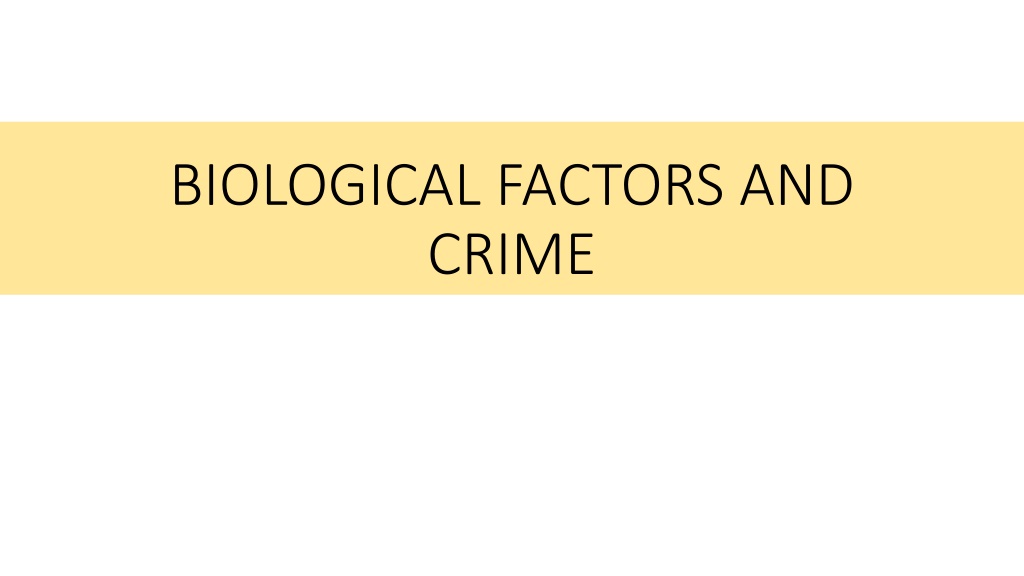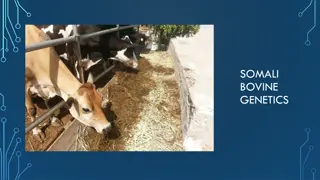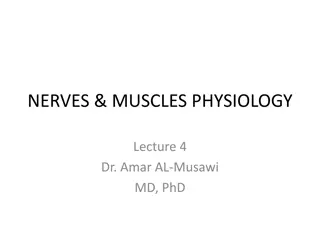Understanding Biological Factors and Crime: Genetics, Neurotransmitters, Neuro-biology
Biological factors such as genetics, neurotransmitters, and neuro-biology play significant roles in influencing criminal behavior. Genetics can predispose individuals to antisocial behavior, neurotransmitters like serotonin and norepinephrine impact social behavior, and neuro-biological damage can lead to impulsive and aggressive tendencies associated with criminality.
Download Presentation

Please find below an Image/Link to download the presentation.
The content on the website is provided AS IS for your information and personal use only. It may not be sold, licensed, or shared on other websites without obtaining consent from the author. Download presentation by click this link. If you encounter any issues during the download, it is possible that the publisher has removed the file from their server.
E N D
Presentation Transcript
BIOLOGICAL FACTORS AND CRIME
Three major factors are responsible for involvement in crime: Genetics Neurotransmitters Neurobiology
GENETICS Genetics affects chronic offending specially in property crimes. A genotype that confers low level of monoamine oxidase enzyme may predispose an individual to violent or antisocial behavior. However it will happen only when that person has been exposed to childhood abuse. There is evidence for genetic influence on criminal behavior but this influence is complex because of the interaction of inherited characteristics and environment.
Neurotransmitters These are chemicals used by the body to communicate between cells. Serotonin : Low levels leads to anti-social behavior. Norepinephrine : Have moderate effect on criminal behavior. Dopamine: Negligible effect Studies have found link between low serotonin activity and childhood conduct disorders, ASPD and criminal behavior. ( crimes involving impulsivity).
Neuro-biology Deals with structure and function of brain. Neurological damage mediates mechanism which leads to offending. Damage to prefrontal cortex is linked to antisocial behavior. It limits the ability to control impulsive, aggressive feelings, encourages risk taking, rule breaking and results in poor reasoning ability. Damage to structure and function of brain can be associated with antisocial or criminal behavior.
Other factors Mental health Other sociobiological Factors
Other factors Mental health: Amalgam of biological (genetics and neurology) and social factors (PTSD,abuse) Can have both, direct as well as indirect links to criminality. Other sociobiological Factors
Other factors Mental health Other sociobiological Factors : Some behaviours (social and individual) are partly inherited and affects behaviour. Early years of a child s life is crucial for brain development and negative impact such as maltreatment, abuse, neglect can predispose an individual to criminality.
Biological Theories of Crime : Sheldon s Constitutional Theory Jacobs, Brunton, Melville, Brittam and McClemont s Chromosomal Theory Mark and Ervin s Dyscontrol Theory
ALBERT BANDURAS SOCIAL LEARNING THEORY Explains how children learn in social environments by observing and then imitating the behaviour of others. Learning could not be fully explained simply through reinforcement, but that the presence of others was also an influence. He noticed that the consequences of an observed behavior often determined whether or not children adopted the behavior themselves.
His Experiment Through a series of experiments, he watched children as they observed adults attacking Bobo Dolls. When hit, the dolls fell over and then bounced back up again. Then children were then let loose, and imitated the aggressive behavior of the adults. However, when they observed adults acting aggressively and then being punished, Bandura noted that the children were less willing to imitate the aggressive behavior themselves.
Banduras 4 Principles Of Social Learning Attention Retention Reproduction Motivation We cannot learn if we are not focused on the task. We learn by internalizing information in our memories. We reproduce previously learned information (behavior, skills, knowledge) when required. We need to be motivated to do anything. Often that motivation originates from our observation of someone else being rewarded or punished for something they have done or said. If we see something as being novel or different in some way, we are more likely to make it the focus of their attention. We recall that information later when we are required to respond to a situation that is similar the situation within which we first learned the information. However, practice through mental and physical rehearsal often improves our responses. Social contexts help to reinforce these perceptions. This usually motivates us later to do, or avoid doing, the same thing.

























